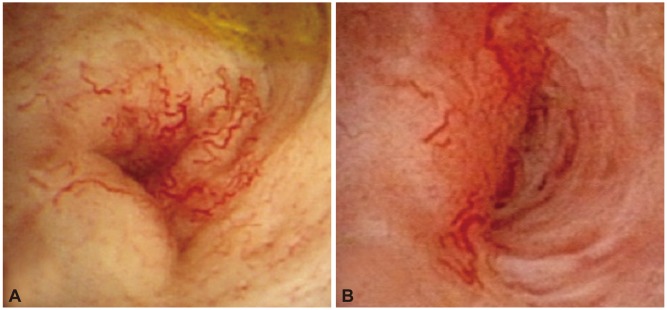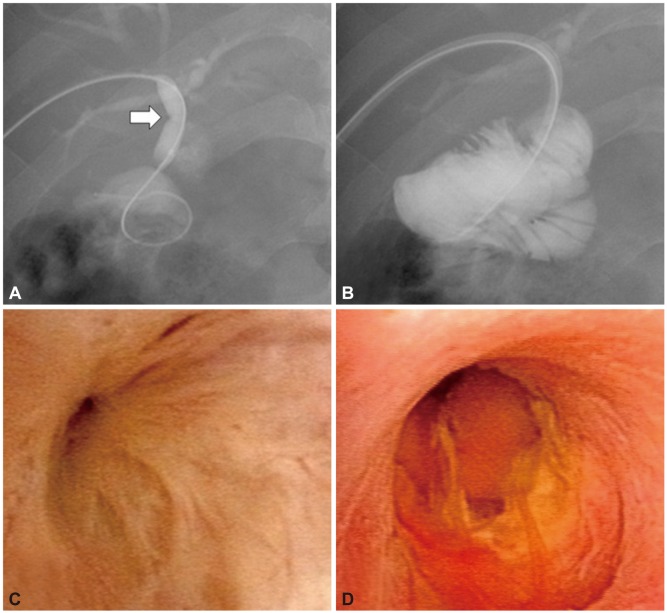Clin Endosc.
2013 Sep;46(5):529-536.
Percutaneous Transhepatic Cholangioscopy: Does Its Role Still Exist?
- Affiliations
-
- 1Division of Gastroenterology, Department of Internal Medicine, Asan Medical Center, University of Ulsan College of Medicine, Seoul, Korea. sklee@amc.seoul.kr
Abstract
- Percutaneous transhepatic cholangioscopy (PTCS) is the most widely used modality for diagnosis and treatment of biliary disease. Although many other novel technologies have been developed based on recent advances in endoscopy, PTCS has its own role. In diagnostics, PTCS is used for evaluation of indeterminate biliary strictures, bile duct tumors, and postoperative biliary strictures that cannot be reached by a peroral approach. In therapeutics, the removal of bile duct stones, dilatation of bile duct strictures including postoperative anastomosis site strictures, and local tumor therapy are indications of PTCS. Especially in a therapeutic role, PTCS has the advantage of maneuverability due to a shorter endoscopic length compared to other cholangioscopic modalities. Hence, PTCS has its own indispensable diagnostic and therapeutic roles.
MeSH Terms
Figure
Reference
-
1. McIver MA. An instrument for visualizing the interior of the common duct at operation. Surgery. 1941; 9:112–114.2. Takada T, Kobayashi S, Yamada A, Uchida Y, Hayashi N. A new technique for the diagnosis and therapy of cholangitic hepatic abscesses; percutaneous transhepatic cholangial drainage (auther's transl). Nihon Shokakibyo Gakkai Zasshi. 1974; 71:657–665. PMID: 4475218.3. Judah JR, Draganov PV. Intraductal biliary and pancreatic endoscopy: an expanding scope of possibility. World J Gastroenterol. 2008; 14:3129–3136. PMID: 18506916.
Article4. Ponchon T, Gagnon P, Berger F, et al. Value of endobiliary brush cytology and biopsies for the diagnosis of malignant bile duct stenosis: results of a prospective study. Gastrointest Endosc. 1995; 42:565–572. PMID: 8674929.
Article5. Macken E, Drijkoningen M, Van Aken E, Van Steenbergen W. Brush cytology of ductal strictures during ERCP. Acta Gastroenterol Belg. 2000; 63:254–259. PMID: 11189981.6. Jailwala J, Fogel EL, Sherman S, et al. Triple-tissue sampling at ERCP in malignant biliary obstruction. Gastrointest Endosc. 2000; 51(4 Pt 1):383–390. PMID: 10744806.
Article7. Schoefl R, Haefner M, Wrba F, et al. Forceps biopsy and brush cytology during endoscopic retrograde cholangiopancreatography for the diagnosis of biliary stenoses. Scand J Gastroenterol. 1997; 32:363–368. PMID: 9140159.
Article8. Seo DW, Lee SK, Yoo KS, et al. Cholangioscopic findings in bile duct tumors. Gastrointest Endosc. 2000; 52:630–634. PMID: 11060187.
Article9. Kim HJ, Kim MH, Lee SK, Yoo KS, Seo DW, Min YI. Tumor vessel: a valuable cholangioscopic clue of malignant biliary stricture. Gastrointest Endosc. 2000; 52:635–638. PMID: 11060188.
Article10. Nimura Y, Kamiya J, Hayakawa N, Shionoya S. Cholangioscopic differentiation of biliary strictures and polyps. Endoscopy. 1989; 21(Suppl 1):351–356. PMID: 2606085.
Article11. Kim EH, Kim HJ, Oh HC, et al. The usefulness of percutaneous transhepatic cholangioscopy for identifying malignancies in distal common [corrected] bile duct strictures. J Korean Med Sci. 2008; 23:579–585. PMID: 18756041.12. Jung JY, Lee SK, Oh HC, et al. The role of percutaneous transhepatic cholangioscopy in patients with hilar strictures. Gut Liver. 2007; 1:56–62. PMID: 20485659.
Article13. Nimura Y. Staging cholangiocarcinoma by cholangioscopy. HPB (Oxford). 2008; 10:113–115. PMID: 18773067.
Article14. Seo DW, Kim MH, Lee SK, et al. Usefulness of cholangioscopy in patients with focal stricture of the intrahepatic duct unrelated to intrahepatic stones. Gastrointest Endosc. 1999; 49:204–209. PMID: 9925699.
Article15. Itoi T, Sofuni A, Itokawa F, et al. Peroral cholangioscopic diagnosis of biliary-tract diseases by using narrow-band imaging (with videos). Gastrointest Endosc. 2007; 66:730–736. PMID: 17905015.
Article16. Lee SS, Kim MH, Lee SK, et al. MR cholangiography versus cholangioscopy for evaluation of longitudinal extension of hilar cholangiocarcinoma. Gastrointest Endosc. 2002; 56:25–32. PMID: 12085031.
Article17. Tamada K, Yasuda Y, Nagai H, et al. Limitation of cholangiography in assessing longitudinal spread of extrahepatic bile duct carcinoma to the hepatic side. J Gastroenterol Hepatol. 1999; 14:691–698. PMID: 10440214.
Article18. Sakamoto E, Hayakawa N, Kamiya J, et al. Treatment strategy for mucin-producing intrahepatic cholangiocarcinoma: value of percutaneous transhepatic biliary drainage and cholangioscopy. World J Surg. 1999; 23:1038–1043. PMID: 10512944.
Article19. Kim YS, Myung SJ, Lee SK, Kim MH. Role of percutaneous transhepatic cholangioscopy in biliary papillomatosis: can it change treatment modality? Gastrointest Endosc. 1998; 47:563–564. PMID: 9647397.20. Lee SS, Kim MH, Lee SK, et al. Clinicopathologic review of 58 patients with biliary papillomatosis. Cancer. 2004; 100:783–793. PMID: 14770435.
Article21. Seo DW, Lee SK, Kim MH. Biliary papillomatosis. Gastrointest Endosc. 2000; 51:67. PMID: 10625800.
Article22. Kim MH, Sekijima J, Lee SP. Primary intrahepatic stones. Am J Gastroenterol. 1995; 90:540–548. PMID: 7717308.23. Chen DW, Tung-Ping Poon R, Liu CL, Fan ST, Wong J. Immediate and long-term outcomes of hepatectomy for hepatolithiasis. Surgery. 2004; 135:386–393. PMID: 15041962.
Article24. Yang T, Lau WY, Lai EC, et al. Hepatectomy for bilateral primary hepatolithiasis: a cohort study. Ann Surg. 2010; 251:84–90. PMID: 20032719.25. Lin CC, Lin PY, Ko CJ, Chen YL, Chen ST, Kuo SJ. Hepatic resection for bilateral hepatolithiasis: a 20-year experience. ANZ J Surg. Epub 2012; 9. 26. DOI: 10.1111/j.1445-2197.2012.06283.x.
Article26. Huang MH, Chen CH, Yang JC, et al. Long-term outcome of percutaneous transhepatic cholangioscopic lithotomy for hepatolithiasis. Am J Gastroenterol. 2003; 98:2655–2662. PMID: 14687812.27. Lee SK, Seo DW, Myung SJ, et al. Percutaneous transhepatic cholangioscopic treatment for hepatolithiasis: an evaluation of long-term results and risk factors for recurrence. Gastrointest Endosc. 2001; 53:318–323. PMID: 11231390.
Article28. Yeh YH, Huang MH, Yang JC, Mo LR, Lin J, Yueh SK. Percutaneous trans-hepatic cholangioscopy and lithotripsy in the treatment of intrahepatic stones: a study with 5 year follow-up. Gastrointest Endosc. 1995; 42:13–18. PMID: 7557170.
Article29. Jan YY, Chen MF. Percutaneous trans-hepatic cholangioscopic lithotomy for hepatolithiasis: long-term results. Gastrointest Endosc. 1995; 42:1–5. PMID: 7557164.
Article30. Chen C, Huang M, Yang J, et al. Reappraisal of percutaneous transhepatic cholangioscopic lithotomy for primary hepatolithiasis. Surg Endosc. 2005; 19:505–509. PMID: 15959714.
Article31. Okugawa T, Tsuyuguchi T, Sudhamshu KC, et al. Peroral cholangioscopic treatment of hepatolithiasis: long-term results. Gastrointest Endosc. 2002; 56:366–371. PMID: 12196774.
Article32. Tsunoda T, Tsuchiya R, Harada N, et al. Long-term results of surgical treatment for intrahepatic stones. Jpn J Surg. 1985; 15:455–462. PMID: 3831500.
Article33. Pitt HA, Miyamoto T, Parapatis SK, Tompkins RK, Longmire WP Jr. Factors influencing outcome in patients with postoperative biliary strictures. Am J Surg. 1982; 144:14–21. PMID: 7091522.
Article34. Collins PG, Gorey TF. Iatrogenic biliary stricture: presentation and management. Br J Surg. 1984; 71:980–982. PMID: 6388728.
Article35. Kim JH, Lee SK, Kim MH, et al. Percutaneous transhepatic cholangioscopic treatment of patients with benign bilio-enteric anastomotic strictures. Gastrointest Endosc. 2003; 58:733–738. PMID: 14595311.
Article36. Kocher M, Cerna M, Havlik R, Kral V, Gryga A, Duda M. Percutaneous treatment of benign bile duct strictures. Eur J Radiol. 2007; 62:170–174. PMID: 17383840.37. Vos PM, van Beek EJ, Smits NJ, Rauws EA, Gouma DJ, Reeders JW. Percutaneous balloon dilatation for benign hepaticojejunostomy strictures. Abdom Imaging. 2000; 25:134–138. PMID: 10675453.
Article38. Bak B, Ornsholt J. Non-absorbable suture material as a nidus for the formation of common bile duct stones. Ann Chir Gynaecol. 1985; 74:146–147. PMID: 4062216.39. Herline AJ, Fisk JM, Debelak JP, Shull HJ Jr, Chapman WC. Surgical clips: a cause of late recurrent gallstones. Am Surg. 1998; 64:845–848. PMID: 9731811.40. Martinez J, Combs W, Brady PG. Surgical clips as a nidus for biliary stone formation: diagnosis and therapy. Am J Gastroenterol. 1995; 90:1521–1524. PMID: 7661183.41. Kinoshita H, Sajima S, Hashino K, et al. A case of intrahepatic gallstone formation around nylon suture for hepatectomy. Kurume Med J. 2000; 47:235–237. PMID: 11059226.
Article42. Yang DH, Lee SK, Moon SH, et al. Percutaneous transhepatic cholangioscopic intervention in the management of complete membranous occlusion of bilioenteric anastomosis: report of two cases. Gut Liver. 2009; 3:352–355. PMID: 20431776.
Article43. Shim CS, Cheon YK, Cha SW, et al. Prospective study of the effectiveness of percutaneous transhepatic photodynamic therapy for advanced bile duct cancer and the role of intraductal ultrasonography in response assessment. Endoscopy. 2005; 37:425–433. PMID: 15844020.
Article44. Jazrawi SF, Nguyen D, Barnett C, Tang SJ. Novel application of intraductal argon plasma coagulation in biliary papillomatosis (with video). Gastrointest Endosc. 2009; 69:372–374. PMID: 18656860.
Article45. Brauer BC, Fukami N, Chen YK. Direct cholangioscopy with narrowband imaging, chromoendoscopy, and argon plasma coagulation of intraductal papillary mucinous neoplasm of the bile duct (with videos). Gastrointest Endosc. 2008; 67:574–576. PMID: 18207145.
Article46. Choi JM, Lee SK, Lee SS, et al. Efficacy of percutaneous cholangioscopic ethanol injection in hepatocellular carcinoma invading the bile duct. Korean J Gastrointest Endosc. 2005; 30:305–311.
- Full Text Links
- Actions
-
Cited
- CITED
-
- Close
- Share
- Similar articles
-
- Percutaneous Transhepatic Cholangioscopy in Bilioenteric Anastomosis Stricture
- Hepatocellular Carcinoma with Obstructive Jaundice Confirmed by Percutaneous Transhepatic Cholangioscopy (PTCS) and Peroral Cholangioscopy (POCS)
- Successful Removal of a Difficult Common Bile Duct Stone by Percutaneous Transcholecystic Cholangioscopy
- Percutaneous Transhepatic Cholangioscopic Intervention in the Management of Complete Membranous Occlusion of Bilioenteric Anastomosis: Report of Two Cases
- Two Cases of Percutaneous Transhepatic Choledochoscopy Treatment of Intrahepatic Duct Stones that Occurred after Living Donor Liver Transplantation





